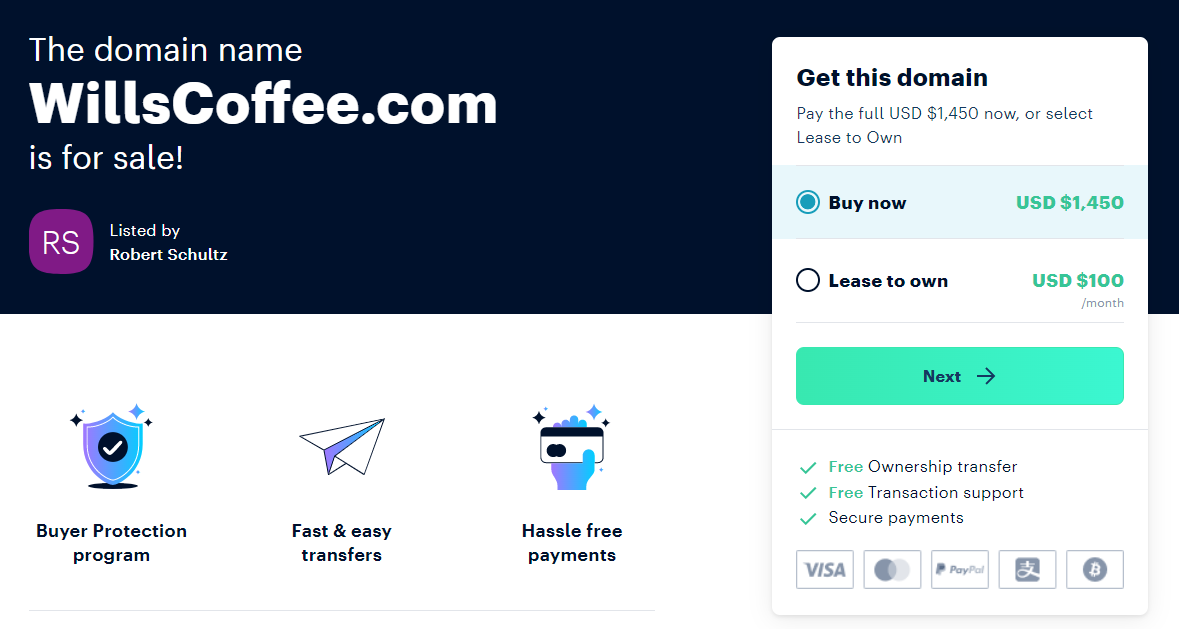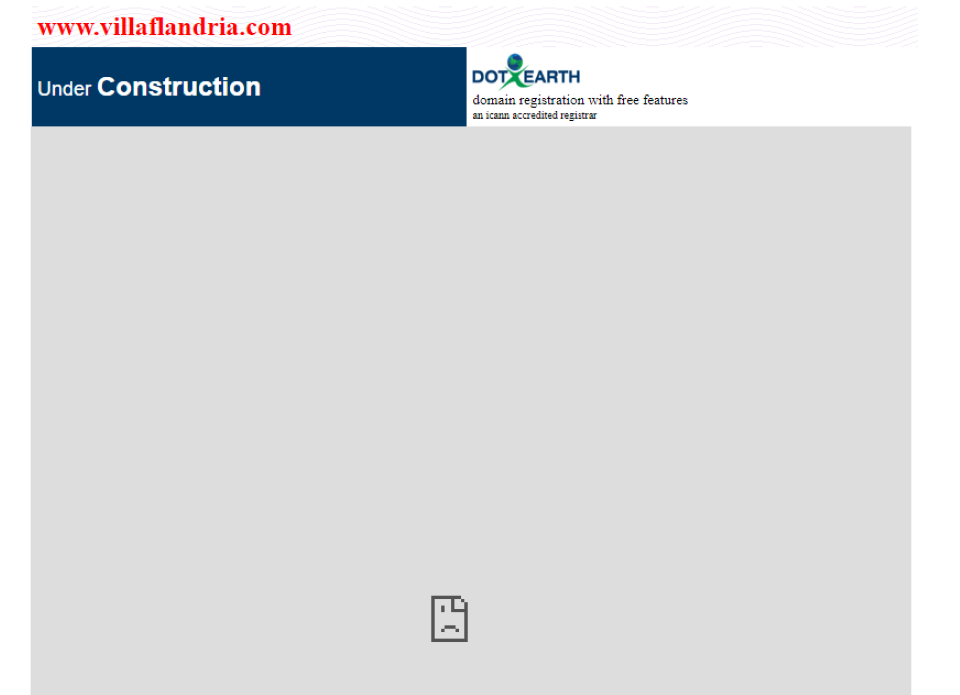In this post, we’ll take a closer look at cybersquatting and what it means. We’ll show you how to recognize it, protect yourself, and steer clear of this practice. Finally, we’ll look at how to claim a domain from a cybersquatter. Let’s jump right in!
What is Cybersquatting?
In a nutshell, it’s the practice of registering domain names that are identical or similar to existing trademarks or company names, and selling them to those businesses at a high price.
A domain squatter purchases generic Top-Level Domains (TLDs) to prevent other users (typically businesses) from registering their brand names. Then they make a profit from reselling these domains to desperate businesses. Companies might also engage in this practice to attract customers from a competitor, or to disrupt another business.
For example, let’s say you run a small coffee shop. If you decide to set up a website using your shop’s name as your domain (e.g. willscoffee.com), you might find that that domain is already taken.
At first, you might think that another business owner runs a coffee shop with the same name as yours. However, when you type the URL into your browser, instead of being directed to a business site, you see a “this domain is for sale” message or something similar:
Domain squatters typically get these names from business directories. Small and new businesses tend to be more vulnerable. After all, they may not have had the time (or budget) to purchase a branded domain name from the start.
That, then, brings us to the question “is domain squatting illegal?” While there’s nothing to stop people from hoarding domains that are similar to existing brand names, the Anti-Cybersquatting Consumer Protection Act (ACPA) gives business owners the right to address trademark infringement in court.
So while there is nothing saying you can’t register a similar URL or exact-match with a different TLD, you will most likely be held liable in court once the infringed brand gets involved.
2 Ways to Identify and Recognize Domain Squatting
Of course, just because your desired domain name is taken, it doesn’t mean someone is trying to make a profit from it. Some cases may be genuine. For example, there might simply be another business with a similar name to yours.
Let’s look at how to identify domain squatting.
1. Check the Website
The easiest way to learn whether your domain name has been taken by a cybersquatter or a genuine user is to check out the website. If the domain directs you to a “normal” website (e.g. an active blog or shop), then it’s probably being used in a legitimate way.
However, if you land on a page that says “this domain is for sale” or “under construction”, it’s likely that you’re looking at a case of cybersquatting:
Alternatively, you might come across a page that’s full of ads. This is mostly common for branded domains, or names based on existing businesses.
For example, let’s say you make and sell camera equipment. If a domain with your brand name takes you to a page that contains nothing but Google ads for cameras and tripods, then someone is probably trying to make money by using your trademark. In this case, you would be the one with the legal protections should you go to court.
2. Contact the Domain Owner
Sometimes, a user might buy a domain name for a project or business that they have yet to launch. Therefore, if the domain takes you to “an under construction” page, it might simply mean that the site hasn’t yet been published.
If you’re unsure, you can try reaching out to the owner of the domain. You can find their name and address by using a tool like who.is:
Note that this information is not always available. Some domain owners choose to hide their personal details using privacy features of most registrars. However, if a cybersquatter is trying to make a profit by selling branded domains, it’s likely that they’ll make their contact details available to the public. After all, how else will they have someone message them with an offer?
3 Ways to Protect Yourself from Domain Squatters
As we mentioned earlier, there’s nothing stopping someone from purchasing a domain that hasn’t yet been registered. This means anyone can register a domain that contains your personal or company name.
However, there are some things you can do to protect yourself from domain squatters. Let’s take a look at the most important steps to take.
1. Register your Domain Name from the Start
The easiest way to stop someone from taking your domain is to register it from the beginning. This means purchasing it before you launch your business.
We recommend that you register your domain when you’re setting up your company. This is a good idea even if you don’t plan to create a website right away. This way, if your desired domain is already taken, it won’t be too late to change your brand name.
2. Purchase Similar Domain Names
You might also want to purchase the same domain name with multiple extensions, such as .com and .net, and even .co. You could also register it with different country codes, like .co.uk and .ca.
Additionally, you might consider registering variations of your domain name, including common misspellings. This will prevent cybersquatters from copying your trademark and trying to lead visitors astray.
3. Buy Domain Ownership Protection
Another way to protect yourself from cybersquatting is to purchase domain ownership protection. This service is normally offered by domain name registrars like GoDaddy. It will keep your domain information private, and you’ll avoid losing your domain if you accidentally let it expire.
How to Avoid Domain Squatting
Domain squatting is different from selling and buying domains (known as “domain flipping”). As mentioned above, cybersquatting is the process of intentionally registering existing trademarks to make a profit.
There are no malicious intentions when it comes to domain flipping. Users who engage in this practice typically purchase domains that reflect popular interests, niches, products, etc.
However, if you’re selling and buying domains, you’ll need to make sure that you’re not unintentionally cybersquatting. If you purchase a trademarked name, you risk potential litigation.
Therefore, you’ll want to steer clear of personal and company names. You might want to use a trademark database to make sure you’re not infringing on any existing brand names.
How to Get Back a Domain Lost to Cybersquatting
If a domain name has been blocked by a cybersquatter, there are some things you can do to get it back. Depending on the price, you might consider paying for the domain name to be transferred to you. In some cases, this is the quickest and cheapest option.
If you’re based in the US, you can file a lawsuit under the provisions of ACPA. However, this is only effective if you can prove that you own the trademark, that the domain name is identical or very similar to your brand name, and that the domain registrant is trying to profit off of you.
Alternatively, you might be able to file a Uniform Domain Name Dispute Resolution Policy (UDRP) proceeding with ICANN. Once again, you’ll need to prove that you’re the owner of the trademark, and that the domain name was registered in bad faith.
Conclusion
Cybersquatting, also known as domain squatting, is the practice of registering domain names that are identical or similar to existing trademarks. This is normally done to attract customers from a competitor, or to sell the domain name to the owners of the trademark — usually at a very high price.
You can protect yourself from domain squatters by registering your domain name when setting up your company. You might also consider purchasing your domain in different extensions and variations and redirecting them all to your site to stop others from copying your name.
Do you have any questions about cybersquatting and how to prevent it? Let us know in the comments section below!
Featured Image via Ribkhan / shutterstock.com




